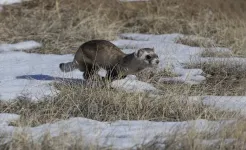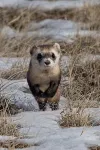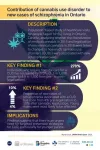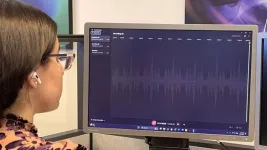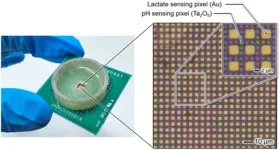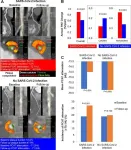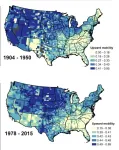(Press-News.org) How do predators use their vision to both navigate through the terrain whilst tracking prey running for its life? Pursuing prey through a complex environment is a major challenge for the visual system as not only do the prey constantly change direction, sometimes in the opposite direction to the pursuer, but running after something evokes self-induced motion-blur which degrades vision. In a study, published in Current Biology, researchers reconstructed the visual fields of freely moving ferrets as they chased a fleeing target. They discovered that the eye saccades, like those that normally track objects when sitting still, aligned the motion of the environment, or optic flow, to the retinas of the eyes while running, instead of tracking the fleeing target. This enabled the reduction of motion blur in the high-resolution retinal specialization, allowing mammals to have clear vision of the environment that they are coursing through.
Saccades do not fixate the target being chased
When sitting still, very rapid coordinated eye movements, saccades, are used to track objects of interest such as a moving object on a screen. But what happens when an animal is running at top speed chasing after prey that is making fast turns to avoid capture? Using head-mounted cameras, a team of researchers from the Max Planck Institute for Neurobiology of Behavior (MPINB) and the Max Planck Florida Institute for Neuroscience measured head and eye rotations in freely moving ferrets to reconstruct the visual fields of both eyes. When running in straight lines after the target, with the target directly in front of the animal’s head, the target’s position was directly on top of the retinal specialization that has the sharpest vision, which was unsurprising. As the ball deviated its course and the animals turned to chase it, saccades were elicited and the target’s position was still held directly on top of the retinal specialization. Surprisingly, digitally removing either eye saccades or head rotations did not significantly change the target’s position on the retina. It was still clustered around the area of the sharpest vision. This suggested that saccades do not serve to align the area of sharpest vision and the target during pursuit as assumed. So, what are the saccades being used for?
Saccades align the world motion to the retina
To solve this, the researchers looked at the pattern of motion of the environment, or optic flow, on the retina and showed that the saccades directed the retinal specialization to point in the animal’s intended direction of movement, which is also the area of least motion blur. This was independent of the target, because the saccades also occurred when the target was absent. “It is very hard to track something that is erratically running for its life, especially when you are also running, but it is easier to predict your own motion and then counteract that motion to enable a clear view of where you are going, the visual systems of mammals seem to have exploited this” explains Damian Wallace, scientist at MPINB.
A generalized mechanism
The same synchronized head and eye movements underlying this were also found in freely moving tree shrews, rats and mice, suggesting a generalized mechanism in mammals. The precisely timed mechanism allows the animal to react very flexible to erratic changes in direction, for example when the prey makes a sharp turn trying to evade capture.
END
The challenge of pursuit – how saccades enable mammals to simultaneously chase prey and navigate through complex environments
Researchers reconstructed what predatory mammals see during pursuit and found that saccades align the retina to world motion and not the actual prey.These eye movements enable the world to remain momentarily non-blurry when chasing erratically moving prey
2025-02-04
ELSE PRESS RELEASES FROM THIS DATE:
Music can touch the heart, even inside the womb
2025-02-04
WASHINGTON, Feb. 4, 2025 – Playing music has long been a way for expectant parents to connect with their children in the womb, but a group of researchers has found evidence it can calm fetal heart rates, potentially providing developmental benefits.
In Chaos, by AIP Publishing, researchers from the Autonomous University of the State of Mexico, the Metropolitan Autonomous University, the General Hospital Nicolás San Juan, and the National Institute of Cardiology Ignacio Chávez studied the effect of classical music on a fetal heartbeat. The team used mathematical analysis tools to identify patterns in heart rate variability.
Typical measures ...
Contribution of cannabis use disorder to new cases of schizophrenia has almost tripled over the past 17 years
2025-02-04
Ottawa, ON, February 4, 2025 – The proportion of new cases of schizophrenia associated with a cannabis use disorder has risen from 4% pre-legalization to 10% after cannabis legalization in Ontario, according to new research.
A new study from researchers at ICES, The Ottawa Hospital, University of Ottawa’s Department of Family Medicine, and Bruyère Health Research Institute and published in the journal JAMA Network Open used data capturing the healthcare visits of everyone living in Ontario, Canada to track whether the liberalization of medical cannabis in 2015 and legalization of non-medical ...
Listening for multiple mental health disorders
2025-02-04
WASHINGTON, Feb. 4, 2025 – It’s no secret that there is a mental health crisis in the United States. As of 2021, 8.3% adults had major depressive disorder (MDD) and 19.1% had anxiety disorders (AD), and the COVID-19 pandemic exacerbated these statistics. Despite the high prevalence of AD/MDD, diagnosis and treatment rates remain low – 36.9% for AD and 61.0% for MDD – due to a variety of social, perceptual, and structural barriers. Automated screening tools can help.
In JASA Express Letters, published on behalf of the Acoustical Society ...
Visualization of chemical phenomena in the microscopic world using semiconductor image sensor
2025-02-04
<Overview>
A research team led by Professor Kazuaki Sawada and Project Assistant Professor Hideo Doi of the Department of Electrical and Electronic Information Engineering, Toyohashi University of Technology has developed a semiconductor sensor enabling the real-time observation of two types of biomolecule dynamics in solutions. By using semiconductor technology to pattern a thin metal film functioning as a neurotransmitter-sensitive membrane on sensor pixels arranged two-dimensionally in a 2 µm pitch, the sensor captures the movement of hydrogen ions and lactate ...
Virus that causes COVID-19 increases risk of cardiac events
2025-02-04
OAK BROOK, Ill. – A new study found severe acute respiratory syndrome coronavirus 2 (SARS-CoV-2) infection was associated with the rapid growth of plaque in the coronary arteries and an increased risk of cardiovascular events. The results were published today in Radiology, a journal of the Radiological Society of North America (RSNA).
“COVID-19, caused by SARS-CoV-2, is initially characterized by acute lung injury and respiratory failure,” said the study’s senior author, Junbo Ge, M.D., professor and director of the Cardiology Department at Zhongshan Hospital, Fudan University in Shanghai, ...
Half a degree rise in global warming will triple area of Earth too hot for humans
2025-02-04
New assessment warns area the size of the USA will become too hot during extreme heat events for even healthy young humans to maintain a safe body temperature if we hit 2°C above preindustrial levels.
For those aged over 60, the same 2°C rise would see more than a third of the planet’s land mass cross this critical ‘overheating’ threshold
An international group of scientists, led by King’s College London, has revealed how continued global warming will lead to more parts of the planet becoming too ...
Identifying ED patients likely to have health-related social needs
2025-02-04
INDIANAPOLIS -- Addressing patients’ health-related social needs such as housing instability, food insecurity, transportation barriers and financial strain is important to improving health outcomes yet can be challenging. A new study from Regenstrief Institute and Indiana University Indianapolis Richard M. Fairbanks School of Public Health investigates the best approach to predicting likely need for one or more health-related social need services.
To identify emergency department (E.D.) patients needing these services, researchers ...
Yo-yo dieting may significantly increase kidney disease risk in people with type 1 diabetes
2025-02-04
WASHINGTON—Body-weight cycling (also known as yo-yo dieting) has been shown to significantly increase the risk of kidney disease in people with type 1 diabetes, regardless of body mass index (BMI) and other traditional risk factors, according to a new study published in the Endocrine Society’s Journal of Clinical Endocrinology & Metabolism.
Yo-yo dieting is defined as repeatedly losing and gaining weight multiple times over the years. Its prevalence is reported to be as high as 35% in men and 55% in women.
This patten of dieting has been shown to increase risks of cardiovascular events ...
Big cities fuel inequality
2025-02-04
A study combining remote sensing and administrative data finds that since the mid-20th century, large, growing cities have ceased to be centers of upward social and economic mobility.
Cities have been celebrated as places of innovation and social mobility but also as hotspots of inequality and poverty. Dylan Shane Connor and colleagues measured how the size, density, and connectedness of urban areas in an American’s birth county predicted their social mobility across the 20th century. The results tell a tale of a waning relationship between ...
Financial comfort and prosociality
2025-02-04
People who feel financially comfortable are more likely to report prosocial actions like donating money and prosocial attitudes than people in a tough financial situation, according to a study. Prosociality—preferences and behaviors that benefit others—is essential to human society. In practice, it is determined by both the desire and the ability to help. Paul Vanags and colleagues analyzed data from the Global Preferences Survey and the Gallup World Poll, including 80,337 people in 76 countries with incomes ranging from about $200 a year to about $380,000 per year, adjusted to be equivalent across the different countries ...
LAST 30 PRESS RELEASES:
The Ceramic Society of Japan’s Oxoate Ceramics Research Association launches new international book project
Heart-brain connection: international study reveals the role of the vagus nerve in keeping the heart young
Researchers identify Rb1 as a predictive biomarker for a new therapeutic strategy in some breast cancers
Survey reveals ethical gaps slowing AI adoption in pediatric surgery
Stimulant ADHD medications work differently than thought
AI overestimates how smart people are, according to HSE economists
HSE researchers create genome-wide map of quadruplexes
Scientists boost cell "powerhouses" to burn more calories
Automatic label checking: The missing step in making reliable medical AI
Low daily alcohol intake linked to 50% heightened mouth cancer risk in India
American Meteorological Society announces Rick Spinrad as 2026 President-Elect
Biomass-based carbon capture spotlighted in newly released global climate webinar recording
Illuminating invisible nano pollutants: advanced bioimaging tracks the full journey of emerging nanoscale contaminants in living systems
How does age affect recovery from spinal cord injury?
Novel AI tool offers prognosis for patients with head and neck cancer
Fathers’ microplastic exposure tied to their children’s metabolic problems
Research validates laboratory model for studying high-grade serous ovarian cancer
SIR 2026 delivers transformative breakthroughs in minimally invasive medicine to improve patient care
Stem Cell Reports most downloaded papers of 2025 highlight the breadth and impact of stem cell research
Oxford-led study estimates NHS spends around 3% of its primary and secondary care budget on the health impacts of heat and cold in England
A researcher’s long quest leads to a smart composite breakthrough
Urban wild bees act as “microbial sensors” of city health.
New study finds where you live affects recovery after a hip fracture
Forecasting the impact of fully automated vehicle adoption on US road traffic injuries
Alcohol-related hospitalizations from 2016 to 2022
Semaglutide and hospitalizations in patients with obesity and established cardiovascular disease
Researchers ‘listen in’ to embryo-mother interactions during implantation using a culture system replicating the womb lining
How changing your diet could help save the world
How to make AI truly scalable and reliable for real-time traffic assignment?
Beyond fragmented markets: A new framework for efficient and stable ride-pooling
[Press-News.org] The challenge of pursuit – how saccades enable mammals to simultaneously chase prey and navigate through complex environmentsResearchers reconstructed what predatory mammals see during pursuit and found that saccades align the retina to world motion and not the actual prey.These eye movements enable the world to remain momentarily non-blurry when chasing erratically moving prey
